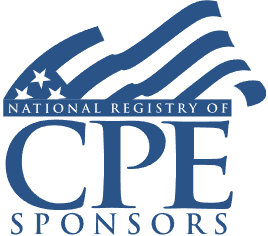Effective Domestic Asset Protection Trusts: Self-Settled Assets, State Differences, Forming and Funding

Course Details
- smart_display Format
On-Demand
- signal_cellular_alt Difficulty Level
Intermediate
- work Practice Area
Tax Preparer
- event Date
Tuesday, January 18, 2022
- schedule Time
1:00 p.m. ET./10:00 a.m. PT
- timer Program Length
110 minutes
-
BARBRI is a NASBA CPE sponsor and this 110-minute webinar is accredited for 2.0 CPE credits.
-
BARBRI is an IRS-approved continuing education provider offering certified courses for Enrolled Agents (EA) and Tax Return Preparers (RTRP).
This webinar will discuss identifying clients who could benefit substantially by forming an asset protection trust (APT), states authorizing domestic asset protection trusts (DAPTs), and considerations of forming and funding these trusts for trust and estate professionals working with high net worth individuals.
Faculty

Mr. Edmondson practices in partnership, corporate, and individual tax planning; business transactions including mergers and acquisitions; business planning; tax controversy; estate and wealth transfer planning; probate; estate and trust litigation; asset protection; and charitable planning. He has conducted, authored, and directed numerous seminars for professional, academic, and civic groups on taxation, business, asset protection and estate planning. Mr. Edmondson works closely with clients to develop and implement such strategies.

Mr. Wolf is a member of the Florida and New York Bars. He has more than 40 years of experience as a trusts and estates lawyer and practices in the areas of estate, tax, asset protection and business succession planning for high net worth families. Mr. Wolf provides sophisticated transfer and generation-skipping tax strategies to successful individuals and advises closely held corporations, partnerships and other business entities on succession and asset protection planning structures.
Description
There are many reasons accountants, trust and estate advisers, and tax practitioners need to understand APTs. They are often the professionals most familiar with a client's financial exposure. Advisers may act as a trustee, and they will most likely be responsible for filing the related income tax returns. Placing assets in an APT can protect from creditors, lawsuits, and future ex-spouses.
Initially, a grantor could not be the beneficiary of an APT. Beginning with Alaska in 1997 and followed by additional states, including Delaware, Nevada, and South Dakota, now 17 states allow these self-settled trusts. Along with offering protection of assets, there are downsides to these trusts, including the fact that they are irrevocable. Additionally, these trusts should be in place before necessary because they are subject to clawback provisions. Properly structured and administered, these trusts are a valuable estate planning tool that can protect vulnerable assets and ensure the transfer of these assets to the desired beneficiaries.
Listen as our panel of trust and estate experts explains how to identify self-settled trusts, the benefits and caveats of these trusts, and how to form and fund a DAPT to limit asset exposure and potential loss of assets.
Outline
- APTs: introduction
- Self-settled trusts
- What is a DAPT?
- Arguments for APTs
- Arguments against APTs
- Forming and funding a DAPT
- State commonalities and differences
- Recent cases
- Alternatives to DAPTs
Benefits
The panel will review these and other critical issues:
- Arguments for and against APTs
- Identifying clients who could benefit from an APT
- Differences among states offering APTs
- Forming and funding an APT
- Recent cases involving APTs
NASBA Details
Learning Objectives
After completing this course, you will be able to:
- Identify specific states offering self-settled trusts
- Decide which clients could benefit the most from an APT
- Determine best assets for funding APTs
- Ascertain when caveats outweigh the benefits of these trusts
- Field of Study: Taxes
- Level of Knowledge: Intermediate
- Advance Preparation: None
- Teaching Method: Seminar/Lecture
- Delivery Method: Group-Internet (via computer)
- Attendance Monitoring Method: Attendance is monitored electronically via a participant's PIN and through a series of attendance verification prompts displayed throughout the program
- Prerequisite: Three years+ business or public firm experience preparing complex tax forms and schedules, supervising other preparers or accountants. Specific knowledge and understanding of estate, gift and trust taxation including various trusts types, the unified credit, and portability.

Strafford Publications, Inc. is registered with the National Association of State Boards of Accountancy (NASBA) as a sponsor of continuing professional education on the National Registry of CPE Sponsors. State boards of Accountancy have final authority on the acceptance of individual courses for CPE Credits. Complaints regarding registered sponsons may be submitted to NASBA through its website: www.nasbaregistry.org.

Strafford is an IRS-approved continuing education provider offering certified courses for Enrolled Agents (EA) and Tax Return Preparers (RTRP).
Related Courses

Family Partnerships: Navigating the Discounting Rules for Family-Controlled Entities
Thursday, March 6, 2025
1:00 p.m. ET./10:00 a.m. PT

Form 1041 Schedule D: Reporting Capital Gains for Trusts and Estates
Available On-Demand

Closer Connection Exception: Determining Tax Home; Treaty Tie-Breakers, Form 8840
Thursday, April 10, 2025
1:00 PM E.T.
Recommended Resources
How CPE Can Bridge the Gap Between What You Know and What You Need to Know
- Career Advancement